Mobile Trio: Gmini mPlay
I already wrote about Creative Airwave HD and insanely cool ROAR , this time I propose to take a look at the devices of a more democratic price range of Russian-Chinese origin. And next time I will introduce you to an interesting piece from Creative, belonging to the same class, but with a bit more functionality.
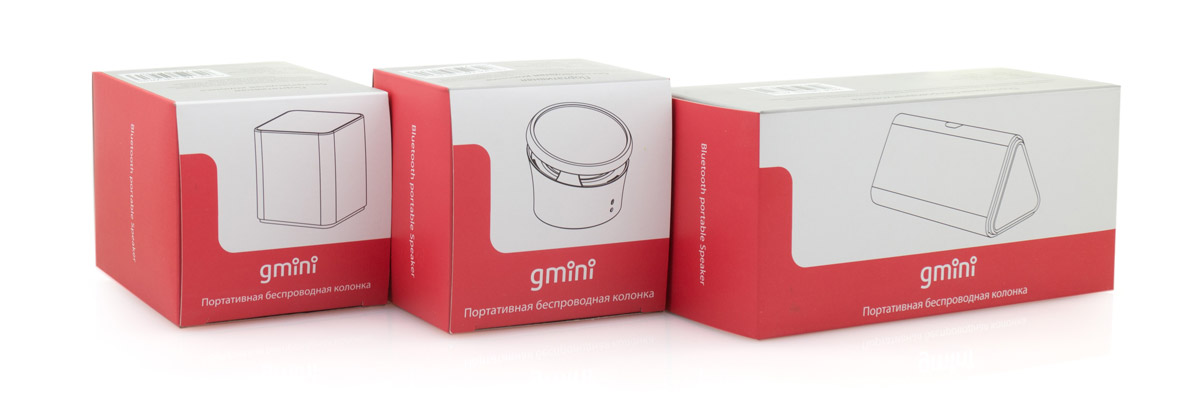
Actually, mobile speakers for connecting to smartphones and laptops do not produce now only lazy, but it is always pleasant to stumble upon the result of high-quality localization and pleasant service, even if there is an ordinary OEM model inside. All three “heroes” of this review are presented by Gmini. The entire mPlay product line in the Russian Federation exists, so far, in three copies: a small DRUMi tablet, its older version is CUBiC, and a funny WiDE stereo clamshell. Well, the Premium segment will be smashed in a week by the Creative SoundBlaster Axx200. Go!
')
The company Gmini, until recently, rather, was known as a manufacturer of electronic books, in Yandex.Market their dime a dozen .

Expansion of the production line is always good, the main thing is not to the detriment of quality. The youngest column in the line - the round DRUMi - was apparently created under the impression of Apple products, since directly advocates the principle of "nothing extra".

Inside - a modest 2.7 W speaker, a battery of unspecified capacity with a stated loudness period from ⅓ to a maximum of about 10 hours, and Bluetooth with an NFC tag. The three-position switch on the bottom allows you to select the operation mode: wireless, wired (via 3.5mm mini-jack), or simply turn off the device.
The case materials are an extremely pleasant tactile soft-touch plastic and a simple silver-matte bezel. The DRUMi is charged by a microUSB connector, but the column itself, unfortunately, cannot offer power to the devices, but it is understandable - not the volumes of the built-in battery to share with anyone else.
The average price for Yandex.Market is 750 rubles.
The average model - CUBiC - is designed much more difficult. First, there are already two loudspeakers here: the same 2.7 W are located on the sides of the cubic "gizmo".
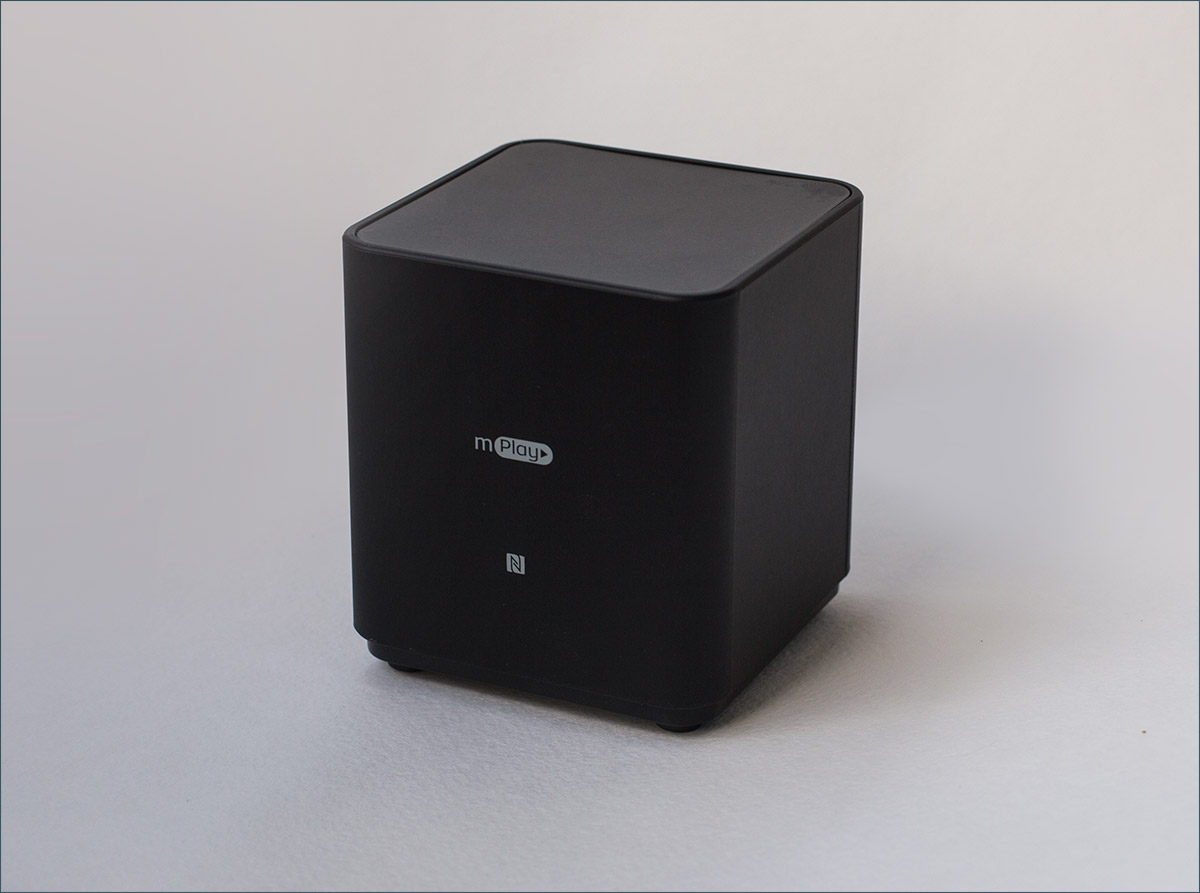
Cubic it is very conditional: first, the corners are rounded, secondly, to start working with the column, you need to slightly press its upper plane: the protective cover rises upward, revealing the speakers behind the protective grid and the column control buttons.
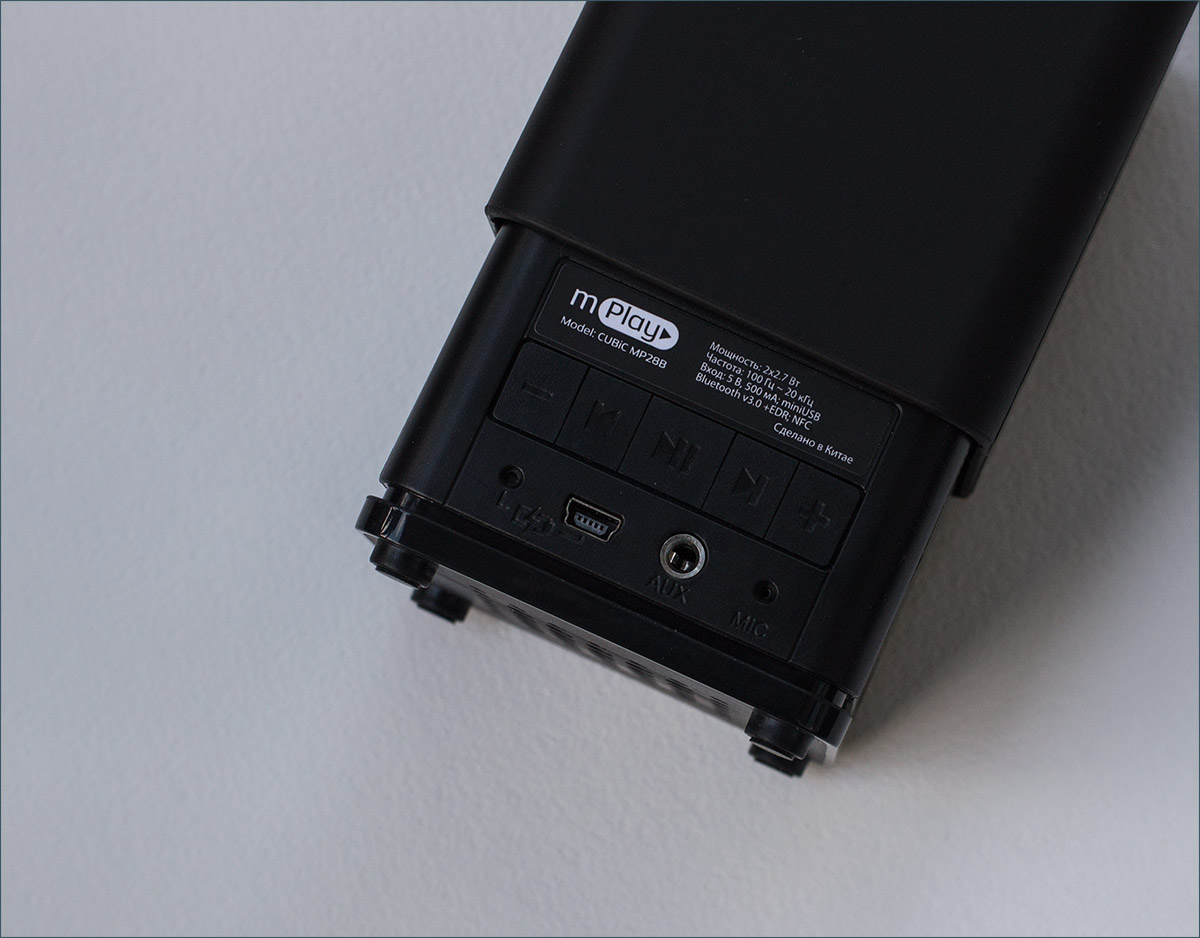
So the cube will turn into a high-tech turret. For the activation of the power is also responsible for lifting the case: opened - on, slammed - off. I do not argue, the solution looks interesting the first five times, but constantly opening and closing the column ... and will not it break? )
The front panel is “decorated” with a slit with a blue LED (it symbolizes the charge of the device and is a normal indicator of the status of the Bluetooth connection). On the back side there are five control buttons (volume ±, play / pause and forward and rewind respectively, a microphone slot, another LED (this time red), a MiniUSB connector for charging the built-in battery and 3.5mm mini-jack as an analog the entrance.
The bottom face contains twenty-five holes and four rubber feet. A bit of a phase inverter adds a little bass: the speaker sounds much nicer than the younger sister, but a little later about the sound capabilities of the whole Gmini trio.
On the Yandex.Market, around 1000 rubles is being asked for, the same prices start at 850 evergreen.
The latest model (the oldest in this line) is Gmini WiDE, a variation of the “cube” made in a different form factor.

The case resembles the Airwave mentioned above: the triangular profile doesn’t give designers any peace. Why two of the casket? Because the body is completely “deaf” and has the only button, by pressing which two speakers leave on the sides. They drive out sedately (the spring is chosen perfectly), with a “velvet” buzz. Original? I do not argue. Need to? It is doubtful.
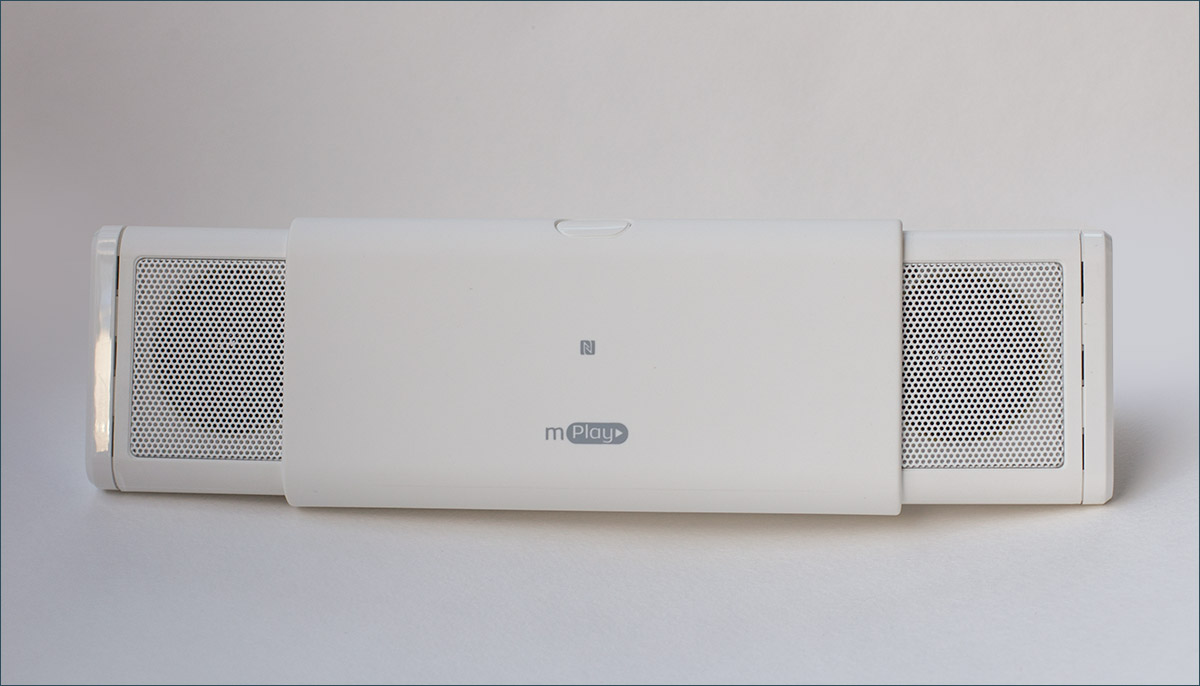
For the sound here, the same 2x2.7 W speakers are responsible, as in the CUBiC. The same battery for 10 hours. In addition, all other functionality, including the control buttons, is painfully similar to the “average” model. The significant difference is the form factor of the case and the relatively wide stereo base of the speaker: if the CUBiC's radiators just look in different directions, and are spaced five centimeters at best, then both speakers are viewed from the front face “at the listener”. A stereo effect appears, but a bit strange.
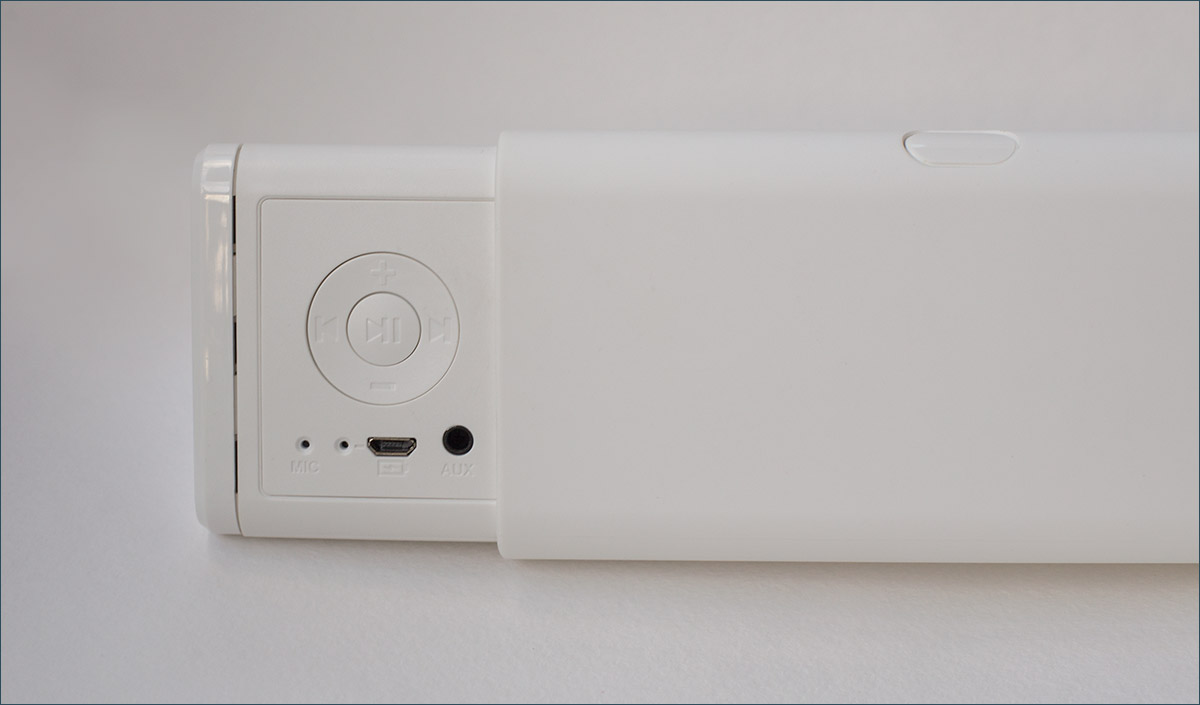
Put in front of the laptop - the column will obviously interfere with the hands. Behind? So she played the cap? It’s trite between the screen and the keyboard (and part of the screen will close), and in those laptops that have a sufficient distance between the edge of the screen and the keyboard, I think there are already quite powerful speakers + an optional subwoofer. Gmini WiDE, theoretically, is useful, rather, for those who want to relax in nature with musical accompaniment - here a portable speaker will be most welcome. Well, in the quality of the audio system to the tablet - also nothing.
For the older model Yandex.Market requests an average of 1,500 rubles. Well, to understand which of the speakers is worth what they ask for it, you need to compare how they sound. What we do.
The competitor and the source of part-time audio will be my unloved MacBook Pro Retina in fifteen-inch performance. He has two speakers, their power is not indicated anywhere, but it can hardly be called "outstanding." But the quality will not stick to the quality, for a laptop such a sound is already good. Low frequencies are not enough, but the overall spectrum sounds clean and detailed.
What can be said about Gmini - the whole trio has more low frequencies than the MacBook speakers. It is understandable, size matters, as they say. The sound quality is more likely to compete with the stereo speakers of the tablets: there is no high intelligibility of the amplifier here: the sound is loud enough, but in terms of purity and detail it is inferior to the macbook.
As for the competition within the line, then everything is also not as clear as we would like. The younger model is clearly designed for smartphones and cheap laptops, everything is forgivable, it tries, as it can, it impresses with its pleasant appearance and very pleasant materials. Taking into account its low cost - a great gift for someone: it is useful, and it looks great, and it sounds more or less pleasant.

CUBiC pleased with the volume and clarity of the sound on the background of DRUMi, a good supply of low frequencies for such a little one, and ... suddenly a more pleasant sound than that of the older brother WiDE. Thanks to the “phase inverter” (in general, the 25 holes at the bottom of the column) and the good internal volume of the column itself.

The older WiDE model, in my opinion, was not saved by either the “extended” stereo base or the beautiful “bjj” when opened. For reasons unknown to me, the most expensive model in the line plays noticeably quieter if not connected to the microUSB connector. As if half strength.

In the open space, the possibilities of the speakers are distributed in the same way: DRUMi is an excellent “expansion” of the smartphone's capabilities at a modest price: in a forest or a park at a picnic, it will play for a couple of meters around, and does not interfere with the others, and the mood raises. CUBiC will sound on the same three, maybe five meters around, but louder. Unfortunately (and, perhaps, fortunately), the noise of the urban environment in the park quickly "eats" the spread of music. WiDE without external power sounds at the DRUMi level.
All three speakers honestly played the whole working day from a single charge of approximately ⅔ of power. That is, 7-8 hours of playback is not a problem. Given the price of devices - an excellent indicator, you can take with you to nature or on a long train ride. Full charge time - about two hours, on purpose did not detect. Energy consumption in both the Bluetooth connection mode and the wire is almost the same. Perhaps when the battery is worn out after a couple of years of operation, the difference will be more noticeable, but a couple of years for a review is too much. :)
Considering the difference in price and the identical capabilities of the middle and high models to overpay for the “stereo base”, I do not consider it appropriate: CUBiC takes up less space, sounds the same / better, costs less. The younger version is well worth the money, but it is better to throw a little and take CUBiC: the price-quality ratio from the whole trio is optimal.
The most pleasant thing about the whole Gmini mPlay line is pleasant body materials, perfectly localized instructions, a neat box. Each speaker comes with a sound cable and a USB-> micro / miniUSB cable. Acoustics look really nice, do not be ashamed to give "as is." Bluetooth and NFC work as it should: music plays, calls and Skype work. There are downsides, so far without them. The main reason for their appearance is the country of origin: bright blue LEDs, which are more likely not suitable for notifying the device status, but for lighting the room, a “zoo” in the form of lack of standardization: microUSB is used in two columns, miniUSB is used in one column , which is rather strange for a single line of models.
What would I change? First, I made a cut-out for the connectors on the back of the CUBiC. Sooner or later, someone will slam it with a stuck MiniUSB or 3.5mm-plug, and that breaks, the connector, board, or housing - a mystery. The body looks reliable. Connectors and cable - not very. ;) Secondly, I would replace the omnidirectional bright blue LED with a neat matte orange / green / white indicator. The key is a matte INDICATOR, not a spotlight. Well, it would be nice to deal with the incomprehensible behavior of WiDE during a power outage: perhaps I just got a bad copy.

Actually, mobile speakers for connecting to smartphones and laptops do not produce now only lazy, but it is always pleasant to stumble upon the result of high-quality localization and pleasant service, even if there is an ordinary OEM model inside. All three “heroes” of this review are presented by Gmini. The entire mPlay product line in the Russian Federation exists, so far, in three copies: a small DRUMi tablet, its older version is CUBiC, and a funny WiDE stereo clamshell. Well, the Premium segment will be smashed in a week by the Creative SoundBlaster Axx200. Go!
')
Tablet
The company Gmini, until recently, rather, was known as a manufacturer of electronic books, in Yandex.Market their dime a dozen .

Expansion of the production line is always good, the main thing is not to the detriment of quality. The youngest column in the line - the round DRUMi - was apparently created under the impression of Apple products, since directly advocates the principle of "nothing extra".

Inside - a modest 2.7 W speaker, a battery of unspecified capacity with a stated loudness period from ⅓ to a maximum of about 10 hours, and Bluetooth with an NFC tag. The three-position switch on the bottom allows you to select the operation mode: wireless, wired (via 3.5mm mini-jack), or simply turn off the device.
The case materials are an extremely pleasant tactile soft-touch plastic and a simple silver-matte bezel. The DRUMi is charged by a microUSB connector, but the column itself, unfortunately, cannot offer power to the devices, but it is understandable - not the volumes of the built-in battery to share with anyone else.
The average price for Yandex.Market is 750 rubles.
Cube
The average model - CUBiC - is designed much more difficult. First, there are already two loudspeakers here: the same 2.7 W are located on the sides of the cubic "gizmo".

Cubic it is very conditional: first, the corners are rounded, secondly, to start working with the column, you need to slightly press its upper plane: the protective cover rises upward, revealing the speakers behind the protective grid and the column control buttons.

So the cube will turn into a high-tech turret. For the activation of the power is also responsible for lifting the case: opened - on, slammed - off. I do not argue, the solution looks interesting the first five times, but constantly opening and closing the column ... and will not it break? )
The front panel is “decorated” with a slit with a blue LED (it symbolizes the charge of the device and is a normal indicator of the status of the Bluetooth connection). On the back side there are five control buttons (volume ±, play / pause and forward and rewind respectively, a microphone slot, another LED (this time red), a MiniUSB connector for charging the built-in battery and 3.5mm mini-jack as an analog the entrance.
The bottom face contains twenty-five holes and four rubber feet. A bit of a phase inverter adds a little bass: the speaker sounds much nicer than the younger sister, but a little later about the sound capabilities of the whole Gmini trio.
On the Yandex.Market, around 1000 rubles is being asked for, the same prices start at 850 evergreen.
Two of the casket
The latest model (the oldest in this line) is Gmini WiDE, a variation of the “cube” made in a different form factor.

The case resembles the Airwave mentioned above: the triangular profile doesn’t give designers any peace. Why two of the casket? Because the body is completely “deaf” and has the only button, by pressing which two speakers leave on the sides. They drive out sedately (the spring is chosen perfectly), with a “velvet” buzz. Original? I do not argue. Need to? It is doubtful.

For the sound here, the same 2x2.7 W speakers are responsible, as in the CUBiC. The same battery for 10 hours. In addition, all other functionality, including the control buttons, is painfully similar to the “average” model. The significant difference is the form factor of the case and the relatively wide stereo base of the speaker: if the CUBiC's radiators just look in different directions, and are spaced five centimeters at best, then both speakers are viewed from the front face “at the listener”. A stereo effect appears, but a bit strange.

Put in front of the laptop - the column will obviously interfere with the hands. Behind? So she played the cap? It’s trite between the screen and the keyboard (and part of the screen will close), and in those laptops that have a sufficient distance between the edge of the screen and the keyboard, I think there are already quite powerful speakers + an optional subwoofer. Gmini WiDE, theoretically, is useful, rather, for those who want to relax in nature with musical accompaniment - here a portable speaker will be most welcome. Well, in the quality of the audio system to the tablet - also nothing.
For the older model Yandex.Market requests an average of 1,500 rubles. Well, to understand which of the speakers is worth what they ask for it, you need to compare how they sound. What we do.
Gmini Sound
The competitor and the source of part-time audio will be my unloved MacBook Pro Retina in fifteen-inch performance. He has two speakers, their power is not indicated anywhere, but it can hardly be called "outstanding." But the quality will not stick to the quality, for a laptop such a sound is already good. Low frequencies are not enough, but the overall spectrum sounds clean and detailed.
What can be said about Gmini - the whole trio has more low frequencies than the MacBook speakers. It is understandable, size matters, as they say. The sound quality is more likely to compete with the stereo speakers of the tablets: there is no high intelligibility of the amplifier here: the sound is loud enough, but in terms of purity and detail it is inferior to the macbook.
As for the competition within the line, then everything is also not as clear as we would like. The younger model is clearly designed for smartphones and cheap laptops, everything is forgivable, it tries, as it can, it impresses with its pleasant appearance and very pleasant materials. Taking into account its low cost - a great gift for someone: it is useful, and it looks great, and it sounds more or less pleasant.

CUBiC pleased with the volume and clarity of the sound on the background of DRUMi, a good supply of low frequencies for such a little one, and ... suddenly a more pleasant sound than that of the older brother WiDE. Thanks to the “phase inverter” (in general, the 25 holes at the bottom of the column) and the good internal volume of the column itself.

The older WiDE model, in my opinion, was not saved by either the “extended” stereo base or the beautiful “bjj” when opened. For reasons unknown to me, the most expensive model in the line plays noticeably quieter if not connected to the microUSB connector. As if half strength.

In the open space, the possibilities of the speakers are distributed in the same way: DRUMi is an excellent “expansion” of the smartphone's capabilities at a modest price: in a forest or a park at a picnic, it will play for a couple of meters around, and does not interfere with the others, and the mood raises. CUBiC will sound on the same three, maybe five meters around, but louder. Unfortunately (and, perhaps, fortunately), the noise of the urban environment in the park quickly "eats" the spread of music. WiDE without external power sounds at the DRUMi level.
Autonomy
All three speakers honestly played the whole working day from a single charge of approximately ⅔ of power. That is, 7-8 hours of playback is not a problem. Given the price of devices - an excellent indicator, you can take with you to nature or on a long train ride. Full charge time - about two hours, on purpose did not detect. Energy consumption in both the Bluetooth connection mode and the wire is almost the same. Perhaps when the battery is worn out after a couple of years of operation, the difference will be more noticeable, but a couple of years for a review is too much. :)
Simple arithmetic
Considering the difference in price and the identical capabilities of the middle and high models to overpay for the “stereo base”, I do not consider it appropriate: CUBiC takes up less space, sounds the same / better, costs less. The younger version is well worth the money, but it is better to throw a little and take CUBiC: the price-quality ratio from the whole trio is optimal.
Pros / Cons
The most pleasant thing about the whole Gmini mPlay line is pleasant body materials, perfectly localized instructions, a neat box. Each speaker comes with a sound cable and a USB-> micro / miniUSB cable. Acoustics look really nice, do not be ashamed to give "as is." Bluetooth and NFC work as it should: music plays, calls and Skype work. There are downsides, so far without them. The main reason for their appearance is the country of origin: bright blue LEDs, which are more likely not suitable for notifying the device status, but for lighting the room, a “zoo” in the form of lack of standardization: microUSB is used in two columns, miniUSB is used in one column , which is rather strange for a single line of models.
What would I change? First, I made a cut-out for the connectors on the back of the CUBiC. Sooner or later, someone will slam it with a stuck MiniUSB or 3.5mm-plug, and that breaks, the connector, board, or housing - a mystery. The body looks reliable. Connectors and cable - not very. ;) Secondly, I would replace the omnidirectional bright blue LED with a neat matte orange / green / white indicator. The key is a matte INDICATOR, not a spotlight. Well, it would be nice to deal with the incomprehensible behavior of WiDE during a power outage: perhaps I just got a bad copy.
Source: https://habr.com/ru/post/235649/
All Articles